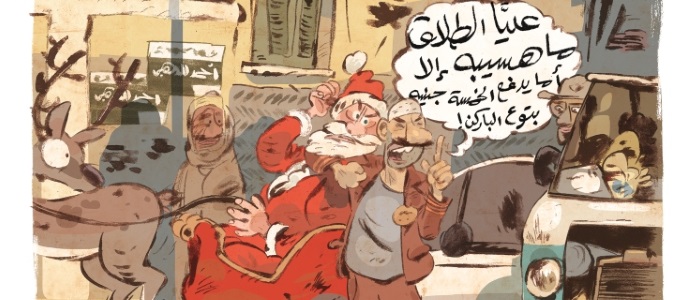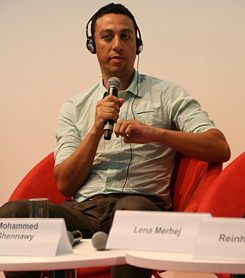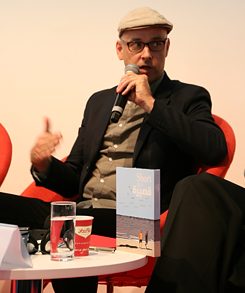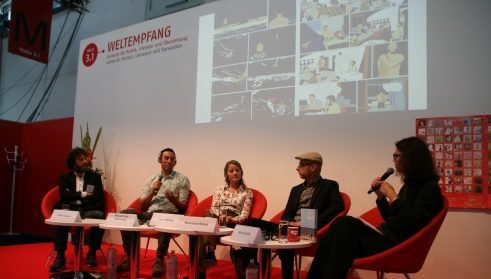Arabic Comics
Often Political, always Art

An exciting look at a creative scene: The Egyptian comic artist Shennawy and others discussed “new Arabic comics” at the Frankfurt Book Fair.
 Shennawy
| Foto: © Christopher Resch
Shennawy
| Foto: © Christopher Resch
At the Frankfurt Book Fair he took part in a discussion with the German-Lebanese graphic designer and artist Lena Merhej, comic artist Reinhard Kleist, and director of the book department at the Institut français in Paris, Didier Dutour. “New Arabic Comics” was the title of the panel discussion – and is also the name of a new book scheduled for release in 2018, a joint publication of the Cairo Goethe-Institut and Institut français.
 Reinhard Kleist
| Foto: © Christopher Resch
Reinhard Kleist
| Foto: © Christopher Resch
One thing became clear during the discussion: the Arabic publishing scene may be deficient in many things – infrastructure, funding, quality printing presses – but there’s no lack of artistic talent. “I conducted many workshops,” said Reinhard Kleist, “and some of the participants were so good that, try as I might, I couldn’t teach them a thing.” Kleist did not discern a specifically Arabic style, but a very personal and sophisticated language of design in each case. “There are a crazy amount of different influences, but many of [the participants] are concentrating on their own unique style. That’s what my workshops try to support.”
In an environment not immune to censorship, this is easier said than done. Even though – and this was exciting to see in Frankfurt – our European priorities in this respect are often much different those of people in the Arab world. Said Shennawy: “Censorship is not really the problem, the problem is funding.” To which his Lebanese colleague Lena Merhej, co-founder of the comic magazine Samandal, replied: “We've already come under fire, have been censored and fined, supposedly because of blasphemy.” What happens after publication is more dangerous than bungling censors anyway. What works in Lebanon – e.g., the open discussion of problems faced by the LGBT community – would be extremely risky for an Egyptian author to address at the current moment.
Didier Dutour has observed some positive developments regarding certain thorny issues. “What’s new is that Arabic comics are politically engaged in topics relevant to civil-society, and this with considerable diversity.” There is rarely a single trigger for social issues impacting art, and in this sense the question of whether the Egyptian revolution of 2011 had a formative influence on Arabic comics is beside the point. “It began much earlier,” explained Shennawy. “Magdy el Shafei’s comic book Metro was published back in 2008. Many things changed, there were small protests and critical movements. Society was basically ready for it.” TokTok as well was first released two weeks before the revolution. “The one was not directly related to the other, but the ground was fertile for change in the arts.” This ferment, already in existence but accelerated, as it were, by the activities of various social networks, was one of the reasons that people then began reading more comics and cartoons. And not just political ones, noted Reinhard Kleist. “There were a lot of everyday stories in my workshops. It was clear that there was a desire not only to address the harsh realities of daily existence, but also to escape from it now and then.”
 Diskussion auf der Frankfurter Buchmesse
| Foto: © Christopher Resch
Diskussion auf der Frankfurter Buchmesse
| Foto: © Christopher Resch
Comics and graphic novels play a big role for many intermediary organizations active in the region. They are firmly embedded in local structures, often being published in the respective local Arabic vernacular and dealing with rather ordinary topics, which makes them more accessible to a broader public than many other forms of culture. “It’s extremely helpful that Institut français and Goethe-Institut have gotten involved,” explained Shennawy, “for the simple reason that it makes our work more visible.” And because they can offer the structural assistance that seems to be so sorely lacking, as Lena Merhej remarked. “We suffer from having to take care of everything: we’re publishers, designers, printers and fundraisers all rolled into one. There’s a general lack of people knowledgeable in the book market.” Shennawy concurred: “I have to do a lot of things that have nothing to do with my actual work.”
Hence more professionalization is needed. But how? Alongside a plethora of socio-political factors, they simply need better printing presses, said Reinhard Kleist. That would be a start. Because, as Shennawy added, “With a freshly printed, aesthetically pleasing product in your hand, it’s easy to sleep at night.”
Author
Christopher Resch is a freelance journalist in Leipzig.
October 2017